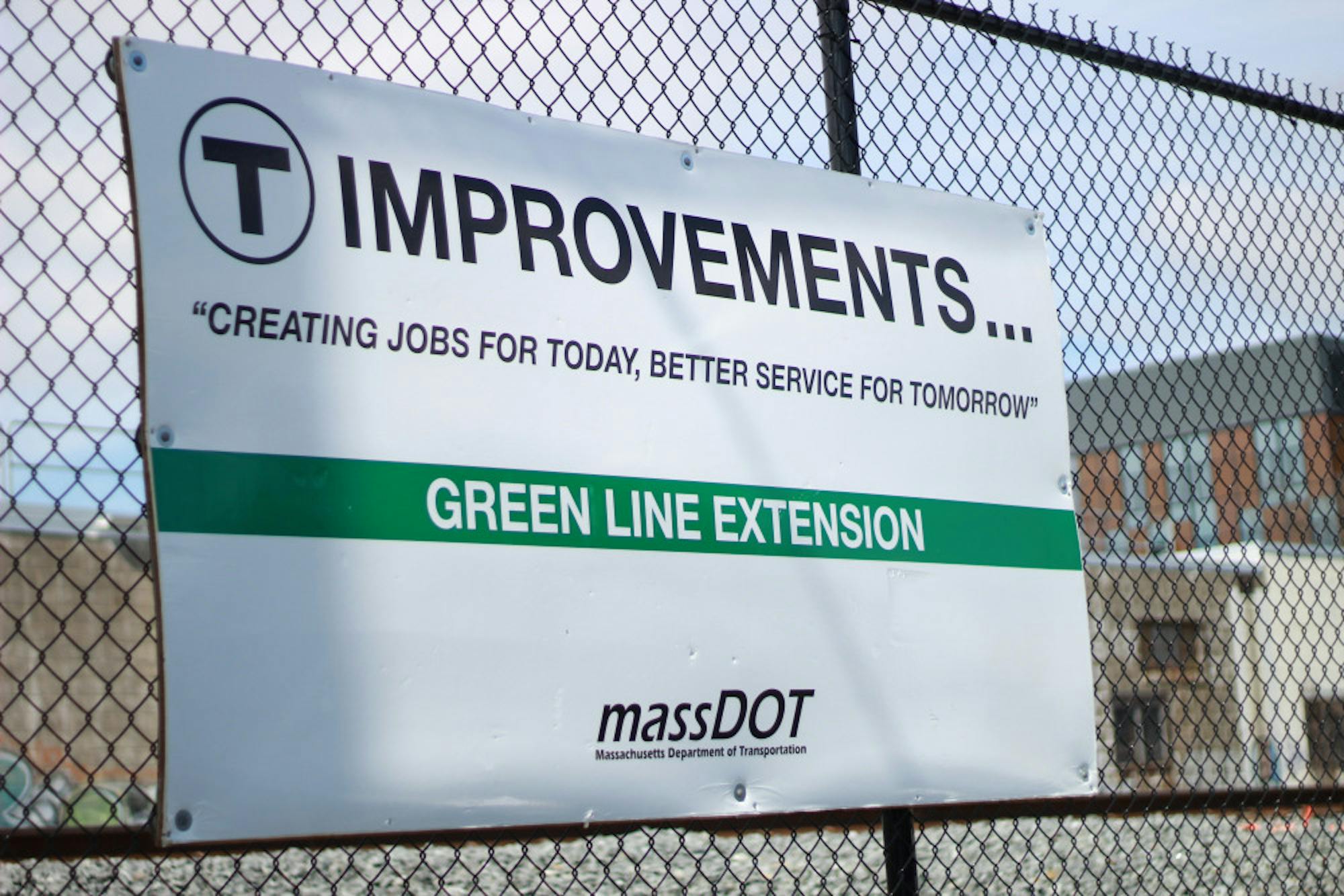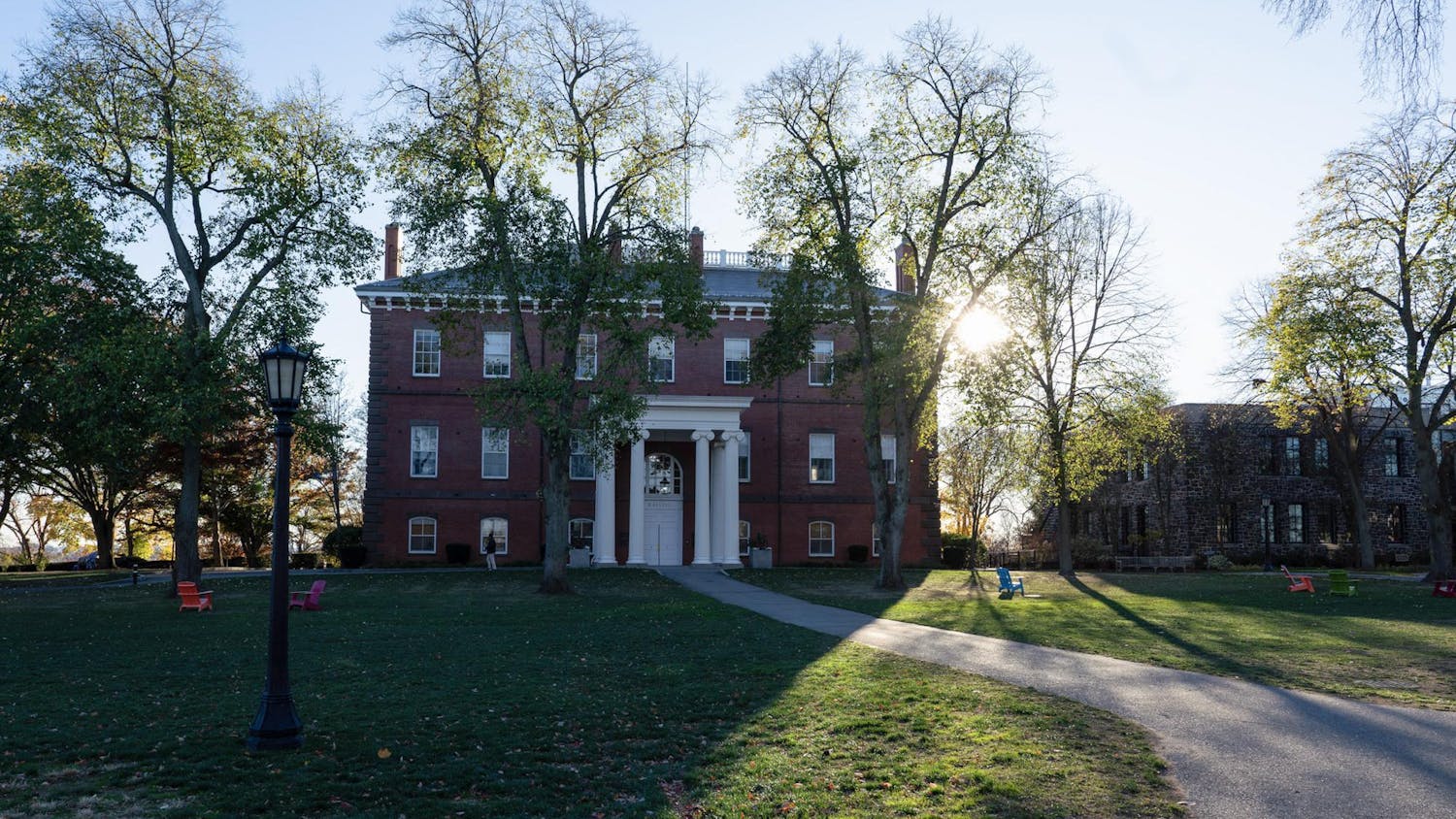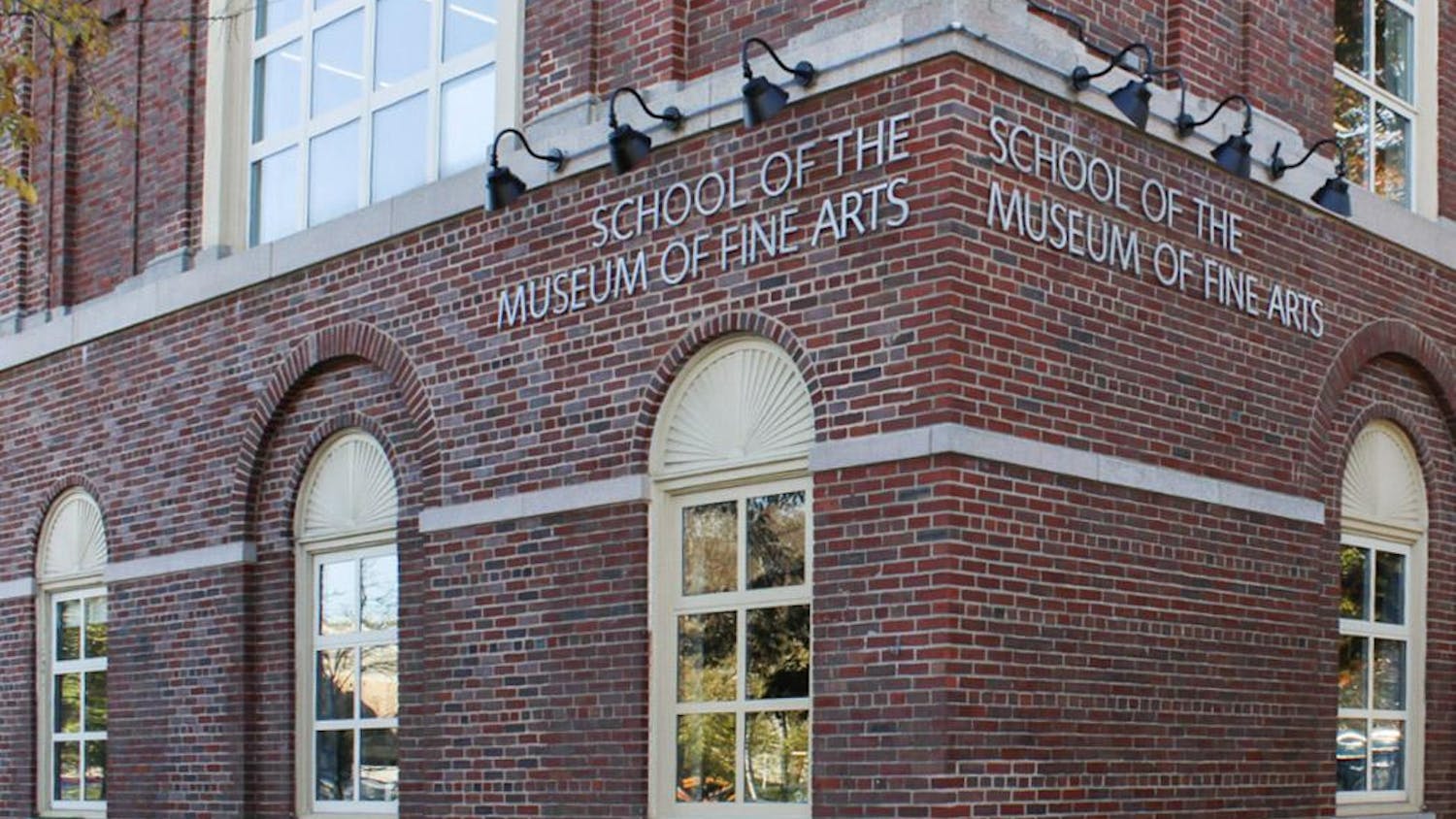Construction of the Green Line Extension (GLX), an extension of the Massachusetts Bay Transportation Authority (MBTA) Green Line from Lechmere Station into the Medford and Somerville communities, has begun after a long search for funding, according to Brad Rawson (AG '12), Director of Transportation and Infrastructure for the City of Somerville.
Current construction work includes geological surveys and clearing paths for new lines, according to Ben Ewen-Campen, the Alderman of Ward 3 in Somerville, and the Green Line Extension website. According to the website, surveys of homes and businesses will focus on minimizing the construction's impact on rodent populations and efforts to keep down noise levels from the completed line.
"Design-build" construction of the GLX
Ewen-Campen said that, although early construction began at the end of March and early April, planning and designing are a continuous process, so the city is only notified of what construction needs to take place on short notice.
“[The GLX] is called a design-build project. We don’t know exactly what’s going to be happening more than a few weeks out at a time,” he said, adding that this created difficulty in communicating with residents about what construction would take place near them.
According to the Design-Build Institute of America website, a design-build project is designed and constructed by a single, streamlined design-build team with both the designer and the constructor, presenting a contrast to traditional project delivery, in which the owner acts with the designer and contractor separately.
Rawson stated that the design-build entity for this project is a body made up of five major companies known collectively as GLX Constructors.
Rawson added that the design-build model was chosen to save the project from a crisis that occurred in 2015 that jeopardized the project. This crisis saw the MBTA terminating its contract with a previous contractor, White Sanska Kiewit (WSK), according to WBUR.
According to Rawson, while the design-build model allowed for the current contract to exist, it carries with it the challenge of giving the contractors more power than the city and citizens in building the GLX.
Rawson said that certain features that the community may want from the GLX may not be feasible under this type of contract.
"Part of the consequences of saving the project when it was on death’s doorstep a couple of years ago was giving the design-build contractor a performance-based environment where there are performance standards that are expected to be met for this part of [the project]," he said. "If the contractor can demonstrate that they’ve met that performance standard, then they’re entitled to build and to invoice for it."
Communicating with Residents
Ewen-Campen said that many Somerville residents are shocked at the immediacy of the project, which was originally agreed upon by the Massachusetts state government in 1990, as it has faced many funding issues and delays with the old contractor in the past that have slowed the development of the line.
“This has been the result of an extremely long and arduous process, and I think there’s still disbelief in the community that this is actually going to happen,” he said.
To improve communication between residents and officials, Ewen-Campen said the Somerville Board of Aldermen voted to hire a GLX liaison.
"We just voted to hire a GLX liaison, which is a specific position in the city for three years to ... be that liaison between what’s going on between the design-build contractors and the residents," he explained. “It’s an enormous amount of work to coordinate that communication [with residents] and ... [understand] resident feedback and concerns.”
A long-awaited extension
According to a timeline on the Somerville Transportation Equity Partnership (STEP) website, the idea to expand the Green Line from Lechmere into Somerville and Medford began as early as the 1920s. The timeline states that the process of fighting for a Green Line extension began in earnest in the 1970s, as Interstate 93 was extended into Somerville, which increased pollution in Somerville.
According to the timeline, the Big Dig, a project which put Interstate 93 into a tunnel under Boston added more highway lanes in the late 1990s and early 2000s.
Rafael Mares, Vice President and Director of Healthy Communities and Environmental Justice at the Conservation Law Foundation (CLF), a New England-based organization that advocates for environmental protection, said the Big Dig further increased pollution in Somerville and heightened the need for a Green Line extension.
"The Big Dig ... did not consider the full impact and the federal law under the Clean Air Act under which we were already, as a region, struggling to meet the national ambient air quality standards, in this case for ozone," Mares said.
Environmental justice along the Green Line
The GLX project was initially agreed upon as an environmental mitigation measure countering the effects of the Big Dig in 1990, after the CLF sued the state for what was seen as development that did not fully consider environmental impacts on surrounding communities, according to Mares.
Referring to a 2006 lawsuit, Mares stated that the CLF won a commitment to the GLX due to the fact that the Big Dig had not considered ambient air quality requirements under the Clean Air Act.
“These commitments and improvements to our transit system were supposed to bring air quality benefits to make sure that our region gets into compliance with the national ambient air quality standards and to balance out the negative impacts expected from the Big Dig,” Mares said.
According to Mares and Ewen-Campen, Somerville and Medford long faced environmental injustice due to projects like the Big Dig, defined by Mares as times during which communities face greater environmental burdens from a project than benefits.
In particular, Mares cited the relative lack of train transportation in Somerville, despite the fact that it is the most densely populated municipality in New England.
“Until the Assembly Square station was recently added, the only subway station on any line in Somerville was Davis Square. Porter Square is near Somerville, but it is in Cambridge, and then you have Sullivan Square which is in Charlestown — it’s near Somerville, but it’s not in Somerville,” he said.
Mares and Justin Moeling, a community activist who lives near Gilman Square in Somerville, where one of the new stops will be built, also stated that immigrant and minority communities near I-93 have faced the bulk of the environmental injustice encountered by Somerville residents. Mares further explained that the GLX extension will serve East Somerville, a part of the city with many low-income residents.
“The properties close to I-93 tend to be state-defined environmental [justice] communities,” Mares said. “Generally speaking, it tends to be that the environmental burdens [are] placed in communities … of color [and] lower-income communities, whereas the benefits tend to be in more white and wealthy areas.”
Mares added that this issue is not isolated to Somerville, but it is a nationwide systemic problem.
Moeling said that any measure necessary should be taken to preserve and increase affordable housing in Somerville, stressing that new legislation is needed to assure that Somerville retains its diverse population.
Construction and funding
According to Mares, the GLX project will come in two phases. For the first phase, the terminus for the GLX is at College Avenue with a second branch ending at Union Square, while the second phase hopes to extend to Medford Hillside with a terminus at Route 16, if leftover funding from the first phase is available for use. Mares said that currently no funding exists for the second phase of the project, as price hikes for the first phase led money from the second phase to be re-allocated to the construction of the first.
However, Mares is hopeful that money left over from the first phase of the project, currently being held as a contingency, will be used to fund the project, as well as refund communities, such as the City of Somerville, that contributed money to the project. According to Ewen-Campen, the City of Somerville contributed $50 million to see the project through.
“The expectation is that that money will be returned to those resources unless something goes wrong with the construction of phase one,” he said.
Expanding transportation in Somerville
Ewen-Campen stated that, although the coming of the Green Line will be beneficial to the Somerville community, other possibilities exist for the expansion of public transportation in underserved communities in the region.
“Out of this entire process, I would say I wish the bus lines were being improved and expanded … Buses are affordable, [there is] less real estate speculation around that,” he said. “Better bus lines would achieve a lot of the same goals and, during the 30-year wait for the Green Line, we should have been [expanding bus lines] as well.”
Rawson also mentioned that bus transportation should be improved in communities around Boston, highlighting the fact that communities such as Everett have introduced dedicated bus lanes to ensure that buses can run on time without being held up in traffic.
Mares agreed, saying that developments of both trains and changes such as dedicated bus lanes should go together, but still asserted the importance of reliable train transportation.
“If you were able to take the Green Line [to downtown Boston], that reduces travel times [compared to bus travel] by up to 75 percent I think, so that’s a huge difference and it increases reliability,” he said, comparing traveling from Route 16 to downtown Boston by bus or by train.
Understanding the GLX in local communities
To foster understanding of the project in the community, Moeling founded the Gilman Square Neighborhood Association to bring together residents of Wards 1, 3 and 4, all of which connect in Gilman Square.
Moeling emphasized the potential for residents to work together for each of their respective goals.
“Everybody’s got their own biases for what they’d like to see [from the GLX], so it’s an interesting opportunity for people to work together,” Moeling said.
Moeling added that some of these opportunities include to educating the community about Gilman Square and the Green Line Extension.
“I got approached by [Innovation Project Specialist] Jason Behrens of Somerville Public Schools to figure out how to incorporate middle school and high school kids on the process of how to incorporate developing the square ... into the curriculum,” he said.
“[Students] have to have more ownership in the square because they’re going to grow up with it,” he added.
Moeling explained that some of the concerns residents faced included the use of eminent domain in the construction process.
“The city can legally take a private property through eminent domain," Moeling said. "They have to have a solid explanation why they have to make that case legally, and then the person is compensated at fair market value for the property."
Moeling added that much discussion in the community centers on what fair market value means.
“There’s a lot of debate as to what exactly is fair market value and who defines that," he said. "I would say a lot of folks are wary of it.”
Moeling underlined the fact that many poorer communities that would benefit from public transportation may not be able to afford to live near the new stations as prices rise.
“The folks that would benefit the most from public transportation would priced out of being able to live near public transportation and have to be further away,” he said. “I think that’s what’s driving a lot of the movement toward preserving affordable housing.”
Mares agreed with Moeling and Ewen-Campen but added that increased public transportation should go together with guards against resident displacement.
“You need to have requirements of affordable housing so when you have a development you have sufficient affordable housing, [but] you have to make sure you do that at the same time as the public transport gets expanded,” he said.
Mares went further, adding that if public transportation were sufficiently expanded, properties near stations would not be much more valuable.
“In many cities around the world, you can go to almost any region ... on a subway, without some communities having higher rent and some having lower rent … The reason for that is you have an extensive public transport system that runs frequently and reliably,” Mares said.
Green Line Extension prompts debate, community efforts to assist development

A sign promoting the MBTA Green Line Extension Project is pictured on April 17, 2018.





